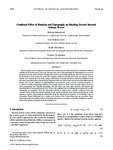Combined Effect of Rotation and Topography on Shoaling Oceanic Internal Solitary Waves
| dc.contributor.author | Grimshaw, R | |
| dc.contributor.author | Guo, C | |
| dc.contributor.author | Helfrich, K | |
| dc.contributor.author | Vlasenko, V | |
| dc.date.accessioned | 2015-11-28T16:16:48Z | |
| dc.date.available | 2015-11-28T16:16:48Z | |
| dc.date.issued | 2014-04-01 | |
| dc.identifier.issn | 0022-3670 | |
| dc.identifier.issn | 1520-0485 | |
| dc.identifier.uri | http://hdl.handle.net/10026.1/3842 | |
| dc.description.abstract |
<jats:title>Abstract</jats:title> <jats:p>Internal solitary waves commonly observed in the coastal ocean are often modeled by a nonlinear evolution equation of the Korteweg–de Vries type. Because these waves often propagate for long distances over several inertial periods, the effect of Earth’s background rotation is potentially significant. The relevant extension of the Kortweg–de Vries is then the Ostrovsky equation, which for internal waves does not support a steady solitary wave solution. Recent studies using a combination of asymptotic theory, numerical simulations, and laboratory experiments have shown that the long time effect of rotation is the destruction of the initial internal solitary wave by the radiation of small-amplitude inertia–gravity waves, and the eventual emergence of a coherent, steadily propagating, nonlinear wave packet. However, in the ocean, internal solitary waves are often propagating over variable topography, and this alone can cause quite dramatic deformation and transformation of an internal solitary wave. Hence, the combined effects of background rotation and variable topography are examined. Then the Ostrovsky equation is replaced by a variable coefficient Ostrovsky equation whose coefficients depend explicitly on the spatial coordinate. Some numerical simulations of this equation, together with analogous simulations using the Massachusetts Institute of Technology General Circulation Model (MITgcm), for a certain cross section of the South China Sea are presented. These demonstrate that the combined effect of shoaling and rotation is to induce a secondary trailing wave packet, induced by enhanced radiation from the leading wave.</jats:p> | |
| dc.format.extent | 1116-1132 | |
| dc.language | en | |
| dc.language.iso | en | |
| dc.publisher | American Meteorological Society | |
| dc.subject | Internal waves | |
| dc.subject | Models and modeling | |
| dc.subject | Nonlinear models | |
| dc.subject | Solitary waves | |
| dc.subject | Circulation/ Dynamics | |
| dc.title | Combined Effect of Rotation and Topography on Shoaling Oceanic Internal Solitary Waves | |
| dc.type | journal-article | |
| dc.type | Article | |
| plymouth.author-url | https://www.webofscience.com/api/gateway?GWVersion=2&SrcApp=PARTNER_APP&SrcAuth=LinksAMR&KeyUT=WOS:000334128200005&DestLinkType=FullRecord&DestApp=ALL_WOS&UsrCustomerID=11bb513d99f797142bcfeffcc58ea008 | |
| plymouth.issue | 4 | |
| plymouth.volume | 44 | |
| plymouth.publication-status | Published | |
| plymouth.journal | Journal of Physical Oceanography | |
| dc.identifier.doi | 10.1175/jpo-d-13-0194.1 | |
| plymouth.organisational-group | /Plymouth | |
| plymouth.organisational-group | /Plymouth/Faculty of Science and Engineering | |
| plymouth.organisational-group | /Plymouth/Faculty of Science and Engineering/School of Biological and Marine Sciences | |
| plymouth.organisational-group | /Plymouth/REF 2021 Researchers by UoA | |
| plymouth.organisational-group | /Plymouth/REF 2021 Researchers by UoA/UoA07 Earth Systems and Environmental Sciences | |
| plymouth.organisational-group | /Plymouth/Research Groups | |
| plymouth.organisational-group | /Plymouth/Research Groups/Marine Institute | |
| plymouth.organisational-group | /Plymouth/Users by role | |
| plymouth.organisational-group | /Plymouth/Users by role/Academics | |
| dc.identifier.eissn | 1520-0485 | |
| dc.rights.embargoperiod | Not known | |
| rioxxterms.versionofrecord | 10.1175/jpo-d-13-0194.1 | |
| rioxxterms.licenseref.uri | http://www.rioxx.net/licenses/all-rights-reserved | |
| rioxxterms.type | Journal Article/Review |


